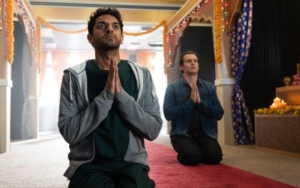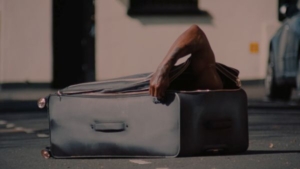At this year’s DOC NYC festival, a trio of films stood out because of their shared emphasis on excess. In two of them, real-life scandals prove the dangers of absolute (or near-absolute) power corrupting absolutely, while the third is set in a country of newfound wealth but loosened cultural restrictions. All three films enjoyed their world, international, or North American premieres, and viewers should keep an eye out for them.
The Kleptocrats, a portrait of shameless greed, begins on one side of the world only to eventually find its way to the other. Jho Low, a Malaysian banker and party boy, spent much of the late 2000s living like royalty, although the exact source of his wealth was a mystery to all. But New York Times reporter Louise Story—who serves as co-producer—and others unearthed a connection between Low and the then-prime minister of Malaysia, Najib Razak, along with an elaborate money-laundering scheme that funneled millions of taxpayer dollars into both men’s pockets. Some of that money went to funding Martin Scorsese’s epic on corporate greed, The Wolf of Wall Street (2013), the irony of which is lost on neither the filmmakers nor interviewees.
Directors Sam Hobkinson and Havana Marking spells out exactly how the con worked, at times presenting the very documents, text messages, and other evidence that prosecutors used to build their cases against Low and Razak. For the most part, the film lets the reporters in America and Asia, who followed the money, guide the story along. Along the way, there are shocking moments, including the revelation of staggering sums of wealth that were transferred to the prime minister, and outrage-inducing descriptions of his crackdowns on the press as it got closer to the truth. The film also features stirring images of mass protests against the government led by students, who take to the streets demanding Razak’s resignation.
The filmmakers repeatedly contrast the spending exploits of Low, Razak, and the latter’s wife with glimpses of the decidedly less glamorous lives of average citizens in Kuala Lumpur. Eventually, the spoils are recovered from a full-scale investigation into government corruption, and the sheer greed and audacity of those involved is difficult to shake. In addition, the film chastises the likes of Martin Scorsese, Leonardo DiCaprio, Robert De Niro, and other entertainment industry figures who more than happily accepted Malaysian money over the years, without ever investigating where it came from. The film stops short of calling these Hollywood players complicit in financial crimes, but it does not do them any favors either, thanks to recorded footage of some of them evading the topic, at times belligerently.
One of the film’s major themes is how putting too much faith in celebrities or politicians is unwise. The real sources of hope that the filmmakers point to include the next generation of politically awakened citizens, who appear determined to sweep out corruption, and the journalists who doggedly pursued the truth no matter what.
The sobering Inside Lehman Brothers also centers on the powerful utilizing their power ruthlessly. Director Jennifer Deschamps exposes a rotten-to-the-core culture through interviews with former employees who blew the whistle on the one-time financial giant for unethical and illegal business practices—the charges would contribute to its collapse. What mattered most at Lehman was making money, and too many employees were willing to do whatever it took to do so, which put pressure on anybody with a scrap of conscience to either fall in line or suffer the consequences.
The most harrowing anecdotes are from a group of employees, all women, who worked at a Lehman-owned mortgage lender during the subprime mortgage boom. They watched as colleagues brought in loan applications that were either questionable or signed by recipients with poor credit ratings, at which point the women were urged to approve them. After reporting what was happening to their superiors, their lives became a living hell of an especially malicious sort as the firm brought in shadowy goons to commit acts of intimidation and outright sexual harassment. Even if the whistleblowers voluntarily left Lehman, there were hints that the firm acted behind-the-scenes to prevent them from landing new jobs, in effect hounding them until their lives teetered on ruin.
Deschamps often frames the female interviewees in their homes, where they appear considerably dressed down. As a result, they appear relatable and, more importantly, vulnerable. Meanwhile, Lehman’s then-chairman, Dick Fuld, makes for an effective antagonist, boasting sneering facial expressions that would look at home on an autocratic dictator. He’s seen in footage telling employees to kill whoever stands in the way of their making money for Lehman. The filmmakers find nothing redeeming about him, although there is something weirdly compelling about his self-absorption and lack of empathy.
Inside Lehman Brothers is mostly told through talking heads, although Deschamps occasionally utilizes helpful graphics, such as flow charts of wide Lehman’s wide reach, to pinpoint how catastrophic its collapse was for the global financial markets. The film jumps between a number of remote locations where interviewees currently reside, which indicates how far they needed to go for peace of mind, although whether that will ever be far enough is a lingering question.
Based on the incidents of misogyny described throughout, Inside Lehman Brothers is highly relevant for a world still awakening to #MeToo. It also walks viewers through the invisible machinations that led to the subprime mortgage crisis, which might seem like old news to some as they’ve been covered by other films, including The Big Short. However, Deschamps argues that the biggest lessons of Lehman’s fall have not yet been learned by everyone, which makes the possibility of a repeat all the more likely—especially given the Trump administration’s laissez-faire stances on financial regulation.
Outrageous at the onset, but ultimately poignant, China Love pulls back the veil on the titular nation’s wedding photography industry, which at last count generated billions of dollars annually. That is an astounding figure, all the more so considering no such industry existed four decades ago, an era in which marriages were typically arranged and photographs were verboten. Director Olivia Martin-McGuire profiles several couples living in modern-day Shanghai to gauge the full effects of this relatively new phenomenon. Some of them have impending nuptials, while others married during the Cultural Revolution five decades ago or even further back in time.
At first glance, the process of having wedding pictures taken seems lighthearted and fun, an exercise in personal expression. The younger couples all visit an enormous photo studio offering every possible backdrop, although the most popular appear to be ones suggesting materialistic comfort or exotic locations outside of China. The more Martin-McGuire cuts back and forth between them, the more the visions of an ideal married life are revealed to be either society’s or their respective families’. What also becomes clearer is that, for many, the institution of marriage is still highly impersonal—we are introduced to a literal marketplace where the parents of unmarried children try to arrange relationships for them.
These scenes make love in modern-day China seem decidedly unromantic, as does a story line that follows the CEO, dubbed the godfather of China’s wedding photography industry, who runs the aforementioned palatial studio in Shanghai containing an endless number of themed sets. This narrative thread definitely provides its share of spectacular moments, including couples hanging by wires in midair or posing in a huge water tank. The behind-the-scenes conditions for the studio’s workers can be harsh, as falling short of perfection can lead to humiliation in front of one’s colleagues.
While it is compelling to see what visual wonders Chinese consumers will spend extravagant amount of money on, the film is at its most compelling when delving into how both young people and their parents are under pressure to make sure the former find partners, wed, and produce children—it’s just different degrees of stress. Martin-McGuire seems particularly empathic toward the brides, whom society considers not marriage material if they are in their late 20s.
In contrast, a not-for-profit offers free wedding pictures for elderly couples as a means of helping them heal from their time spent living under a repressive regime, when acquiring photographs of any sort would have been viewed as capitalist and shameful. By spending time with these older folks, we bask in their sense of joy and happiness to finally commemorate their unions. Interestingly, the photos provided by the nonprofit are decidedly less opulent than the big studio’s, yet the reactions to them are the most touching, reminding us love and marriage can still go hand-in-hand.


















Leave A Comment